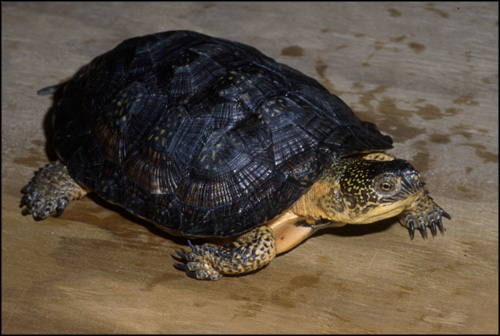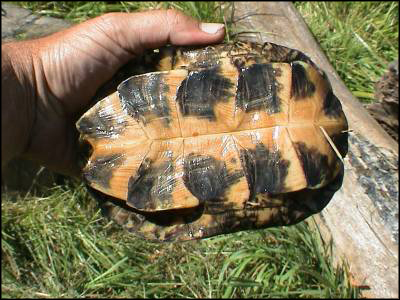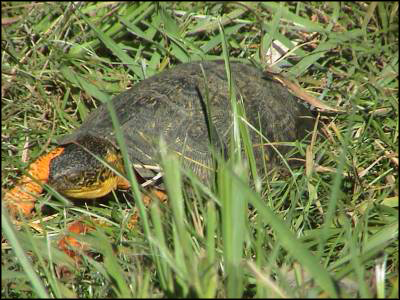Blanding's x Wood Turtle Hybrids

© 2004 James H. Harding
Emydoidea blandingii X Glyptemys insculpta
Every once in a while, something truly out of the ordinary catches one's attention. Such was the case a few years back while attending the professional herpetology meetings in Guelph, Ontario, Canada.
Jim Harding had submitted an abstract for a talk he was going to give on hybrid turtles from two different GENERA, never mind different species! What a fascinating presentation that turned out to be! This wasn't just a single freak individual seen in the wild, but rather, it was full-blown DNA evidence. Although I don't normally include literature citations throughout this website, due to the unusual nature of the turtle pictured above, the citation is included and can be downloaded by clicking on the citation:
Harding, J. H. and S. K. Davis. 1999. Clemmys insculpta (Wood Turtle) and Emydoidea blandingii (Blanding's Turtle).
So, how did this happen? As
it turns out, Jim was excavating a nesting site in a small research
enclosure during August of 1997, when he came across some weird looking
hatchlings. Based on the fact that the only adult male Wood Turtle
in the pen had sustained serious injuries to its reproductive organs,
during an attack by a raccoon, Jim suspected the hatchlings might be
hybrids. One hatchling, that had been accidentaly killed during
the excavation, was sent to Scott Davis at Texas A & M University
for DNA analyses. Using mitochondrial DNA (mDNA is passed down
through the maternal line...let's call it "Mom DNA"), Scott
was able to deduce that the mother of these hatchlings had been a Wood
Turtle. Then, using a "microsatellite" method,
he was able to do the dreaded 'paternity test'. As it turns out,
dad was a Blanding's Turtle!!! Scandalous! If that wasn't
enough, another clutch of hybrids was produced in 1998...and again in
1999!
So, what's the big deal, scientifically speaking? Well, would
the little ones grow up to have a plastral hinge like dad? Would
they be fertile? Would the sex of their offspring be determined
by temperature like dad, or genetically like mom? Wow! How
about the basic structure of the shell? High domed like a Blanding's?
Sculptured like a Wood Turtle? All kinds of interesting
questions!
Here are a few more pictures of the "Harding Hybrids"

© 2004 Darrell Senneke

© 2004 Darrell Senneke
I should also mention that, two
decades ago, Dr. Carl Ernst published a note about a hybrid between Clemmys guttata and Glyptemys muhlenbergi (although both
were in the same genus in 1983). Unfortunately, we didn't have the genetic
tools we have now to confirm the hybrid status. Interested readers should
obtain the following article, available in your local university library.
Ernst, C. H. 1983. Clemmys
guttata (Spotted turtle) X Clemmys muhlenbergii (Bog turtle). Natural hybrid. Herpetological Review 14: 75.
Last updated: February 7th, 2010
Dr. Raymond A. Saumure © 2002-2010 • All Rights Reserved
